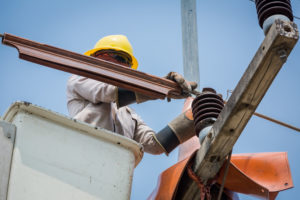
ENR.com and the Construction Financial Management Association (CFMA) recently published some articles suggesting that “cash-strapped public and private owners are shifting greater risk onto contractors through onerous deal terms” [Owners Shift More Financial Risk as Recovery Remains Sluggish]. This is true, but it’s not necessarily new. As this article will explain, this risk shifting tug of war has been going on for over 200 years. Nevertheless, it doesn’t minimize the importance to subcontractors and suppliers to understand the game and prepare for it.
History of Owners Shifting Risk Down The Contracting Chain
In 1791, Thomas Jefferson invented the mechanics lien, and in doing so he set forth the unique American policy that subcontractors and suppliers should be paid on every project, and that the financial risks on construction projects should be shouldered by developers. Mechanics lien laws were quickly passed in every state across the nation, and in some instances, even inserted into state constitutions.
It’s the US public policy that financial risk should be shouldered by property owners and developers. Did you pick up on what I just said there? It’s the US public policy that financial risk be shouldered by property owners and developers.
Do you believe me? Consider this:
- Every state has mechanics lien and bond claim laws which are designed to protect subcontractors, suppliers, laborers and those down the contracting chain from non-payment.
- Every state has some form of “prompt payment” laws that apply only to the construction industry.
- In many states, misappropriating construction funds is a crime.
- States have laws that restrict how much retainage can be withheld from a sub-tiers contract
I could go on and on. State statutes are riddled with legal provisions to prevent those with the money (i.e. owners and generals) from taking advantage of those without (subs and suppliers). If that is the case, why in the world is it so difficult to get paid in the construction industry?
The answer is that owners and their lawyers have been working for 200 years to contractually shift the financial risk on projects. That is precisely what ENR and CFMA are currently warning about here: Owners Shift More Financial Risk as Recovery Remains Sluggish.
To combat the legal provisions and policy protecting subcontractors and suppliers, owners are constantly conjuring up new contractual provisions to offset the laws. Here are some example provisions designed to shift the risk down the contracting chain:
- Pay when paid clause
- Pay if paid clause
- No lien clauses
- Claim notice provisions
- Retainage Requirements
- Payment bond requirements
Owners have been using these provisions to shift the financial risk on construction projects for generations, and there is a battle between what controls: the law’s public policy or the contract terms. In many cases, you’ll find that the courts invalidate contract provisions that conflict with the state’s public policy protecting subcontractors and suppliers. However, how courts will rule on the issue varies with each generation, court, and circumstance (Boooo!).
What You Can Do To Balance The Risk Shifting Efforts of Owners
Something mentioned in the ENR article about financial risk shifting is dead-on accurate: “The financial consequences of risk-shifting are hitting subcontractors first since ‘they are furthest from the cash flow.'”
The financial consequences of risk-shifting are hitting subcontractors first since ‘they are furthest from the cash flow.’ This is a sobering statement.
Being a subcontractor (or a supplier) is a perilous endeavor. The construction industry boasts the highest business failure rates in the nation. Financial risk mitigation efforts are being employed by parties subcontractors and suppliers cannot control (i.e. between the GC and the Owner), but the effects of those efforts are hitting the subcontractors and suppliers.
This all seems horribly unfair…but wait…
The financial risk shifting game has been a cornerstone of the American construction market since the late 1700s, and so the nation’s laws have created legal tools for the subcontractors and suppliers to use to offset that uncontrollable risk. There are many tools, but as we’ve suggested in the past, the mechanics lien laws are by far the most effective for protecting your right to payment and simply getting paid.